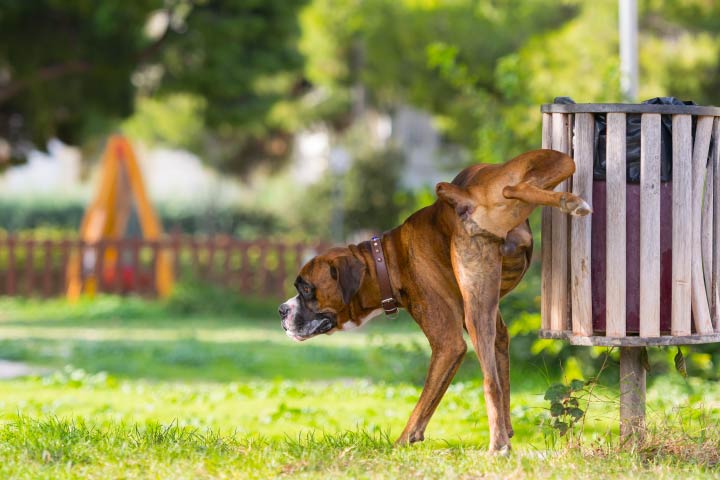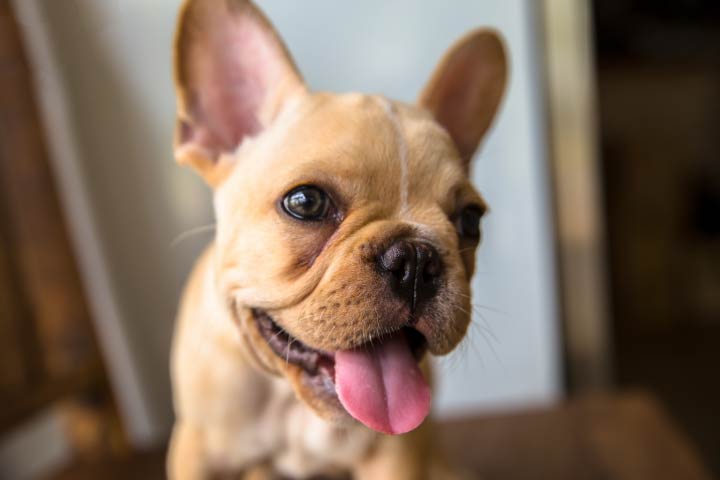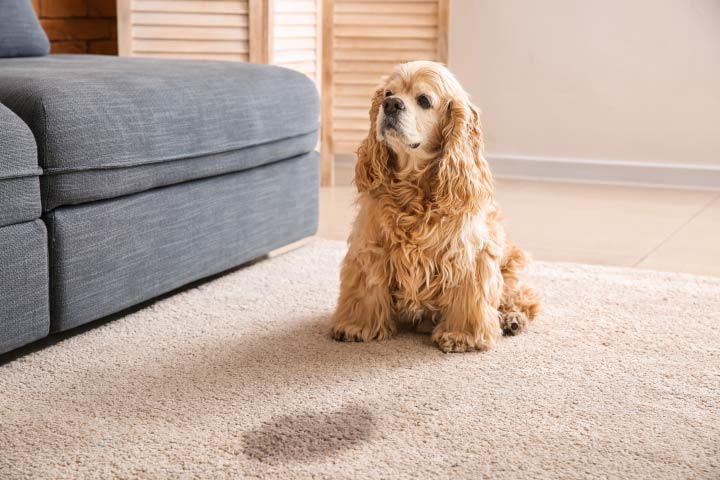
Ask almost any pup parent and they’ll tell you their pooch takes a special interest in being outside. There’s apparently all kinds of interesting smells, sounds, things to see…and things to pee on.
If you’ve been on a walk with your dog and find yourself stopping every two minutes for him to go through a ritual of intense sniffing, circling, and finally relieving himself on some poor fire hydrant, tree, lampost (or your neighbor’s mailbox), you’re not alone.
A dog’s outdoor urinary behavior is quite normal most of the time, but can be concerning to some folks, especially new pup parents who wonder if there isn’t a behavioral or medical problem present making their pup stop so often to pee outside.
In this article we’re going to discuss some reasons why dogs find the need to pee on things so much outside, especially on seemingly random objects around the neighborhood. We’ll also review when frequent urinary behavior may actually be more concerning for the start of a medical issue your veterinarian should get involved with.

Why Does My Pup Pee on Things?
We’ll first start out with reasons why dogs feel the need to pee on things outside at all.
Of course, everybody’s got to go sometime. It’s just a fact of nature that we all have to pee to eliminate fluid waste from the body. But we humans typically just pee when we need to. It’s kind of a one and done until the next time. Sometimes, this is also the case with dogs. You let her out in the backyard, she squats to pee, and comes back in. Or, maybe you go out for a short walk, she picks somewhere good to pee, then doesn’t pee for the rest of the walk, or wants to go back inside.
But many pup parents realize at some point early in their relationship with their furry friend that instead of one good pee on a walk, there are multiple episodes of small pees. This is accompanied by a great deal of ritual sniffing and investigation. This frequent urination behavior is what may raise concerns for some kind of true problem.
But I have good news for you! Because most of the time, these frequent pees outside are actually part of a perfectly normal behavior. Yes, even if it is your neighbor’s mailbox.
It’s normal for dogs to urinate around their environment as a means of communication to other dogs, referred to by some humously as “pee-mail”. The desire to engage in “pee-mail” on your walks together can depend on a few factors and situations.

Environmental Advertising (Why Dogs Pee on Fire Hydrants)
Your pup’s environment encompasses a lot of areas, not just your immediate home. This includes her normal walking routes as well as any places like parks, that you go to play.
If something about this environment seems different to your pup, she may choose to urinate on certain landmarks, like the corner fire hydrant, or the base of a tree, to communicate to other dogs that she’s been there and that this is part of her territory.
And why are vertical objects so popular? According to a trainer with whom I consult often, vertical objects, like trees, hydrants, and posts, are better for advertising. On a vertical surface, the scent your dog leaves from peeing as high up as possible will carry much better through the air to be picked up by other dogs. On the other hand, pee on the ground just soaks into the ground and can’t carry very far at all.
In addition, the height of the urine mark may also convey a message to others about the size of the dog who leaves it, as well as a more superior statement of dominance. Larger dogs can naturally urinate much higher on a surface than a small dog. And this is why you can come across amusing pictures of very small dogs practically doing handstands so they can position themselves to pee as high up on a tree trunk as possible. The higher the mark, the bigger and badder I am.
This is also why dogs who are urine marking typically lift their legs to pee instead of squatting. Lifting up a hind leg allows for targeting much higher up a surface. Even female dogs, who tend to squat more to pee in general, may lift their leg when trying to leave a “pee-mail”.
Dogs have a sense of smell about 40 times that of our own, according to NOVA of PBS. This is hardly possible for us to imagine, but it means that your pooch can pick up multiple individual scents where you may not be able to detect anything.
When your pup is intent on sniffing a certain area on one of your walks, he’s detecting multiple scents and signals where another dog or other animal has been. A dog can detect gender, reproductive status, and likely other traits about another pup based on urine alone.
If your dog comes across scents from a non-resident dog, a “rival”, or any other scent he doesn’t care for, he may choose to do what’s called “overmarking”, which is urinating on top of another animal’s previous urine mark. This covers up the previous urine mark, replacing it with his own.
Dogs may also urinate on objects, just to claim them as their own, whether there’s another animal’s scent on it or not. Consider bringing in a new chair or sofa into your home. If you’ve ever seen your dog pee on it shortly after, this is most likely the reason why. It just didn’t smell like him, and he wanted it to.
This can be frustrating and inconvenient to be sure, but it is still technically a normal behavioral response.
The Birds and the Bees
A pup’s reproductive status can be a major factor contributing to how extensive marking behavior can be. Dogs who have not been spayed or neutered tend to engage in marking behavior far more than pups who have been “fixed”.
Intact male dogs do this most often. Some of this is related to territory and dominance while some is also sending a signal to any available ladies on the same walking route that there’s an eligible bachelor nearby.
Intact dogs, especially males, may also urine mark in the presence of another dog. This is a similar situation. To other males, he’s sending a signal that he owns this route, while to females, he’s trying to send a signal of availability.
Intact females urine mark less than males, but we can see an uptick shortly before she goes into heat or shortly after. During this phase, her urine is saturated with hormones that signal she’s available soon for mating, and she wants to make sure any males in the area are aware.

My Dog Pees When Excited (And Other Quirks)
Dogs can exhibit very complex social structure and we can see part of this with urinary behavior. I’ve already mentioned that in the presence of a rival male or a receptive female, an intact male dog may choose to urinate on a nearby surface.
Dogs may urinate in the presence of others to display dominance or mating availability, as in the above example, or submission. If your pup has ever encountered another dog, tucked his tail under and squatted to pee, this can be a sign of submission. He’s trying to send the signal that he’s not a threat, and is possibly even nervous about a potential negative interaction.
Conversely, you’ve probably encountered an overly excited pup on a walk (maybe this was even your own pooch!). With a tail wagging so fast you can hardly see it and a butt wiggle to boot, this pup jumps, play bows, and then piddles on the sidewalk.
An excited pee is really just a consequence of overstimulation. This can occur with a single interaction with another dog, or may be related to an environment, like the vet hospital, or even your own home if you have a large number of guests over for a party.
This type of urinary behavior is dependent on the dog’s individual nature and is generally so reliable that we keep alerts in our medical records for both excited urinators as well as submissive urinators, so that we make sure to have an extra towel handy when they come into the clinic.
How to Address Outdoor Urinary Marking Behavior
When looking to address this behavior, the first thing to keep in mind, is that in most cases, this behavior is completely normal. In fact, dissuading your dog too much from engaging in marking outside may lead to confusion and possibly development of indoor marking issues, which is a whole nother discussion.
Spaying and Neutering
We can see marking behavior start to develop as early as 3 months of age and most dogs who develop the behavior have done so by 2 years.
This is a pretty wide age range and understanding just how much spaying or neutering may help with excessive marking behavior may depend greatly on timing.
Many types of behaviors can be worked on and adjusted prior to one year of age. However, after that time, it’s much more difficult to condition a dog out of certain ingrained habits. This is where the phrase “you can’t teach an old dog new tricks” comes from.
So if you have a young pup who’s 6 or 7 months old who marks excessively, spaying or neutering is likely to make a significant difference, along with some focused training. If let’s say you adopted a dog at 3 years of age who marks a lot, neutering may still help, but as an ingrained behavior, you might only see up to a 50% improvement.
Say No to Saying No
In the vein of understanding that marking behavior is normal, it’s really best to let it happen, as discouraging a normal behavior can lead to confusion and other, less desirable behavior problems at home.
That isn’t to say that we should let our pups pee on just about whatever they want outdoors. My neighbors who have a sign in their yard that reads “Keep Off the Grass (Dog Pee is Killing Our Lawn)” probably wouldn’t appreciate a pup peeing on their grass, much less their mailbox post.
So if there is an area that is socially inappropriate for your pooch to pee on, try to avoid that particular area if you can by walking on the other side of the street or heading in the opposite direction.
If a particular area is unavoidable, you can try to put a positive spin on discouragement by using a command like “leave it”. Then, get your pup to sit near the surface he’s interested in but focus attention on you instead, and give him a small treat if he complies. Then continue on your walk. At first, this may take several tries, but with a well-trained dog who is well-motivated by food, you can usually make good progress.

Indoor Urinary Issues?
This article doesn’t cover indoor urinary marking, pups having pee accidents inside the home, or potty training. That’s because we’ve already covered those topics in other articles!
For more information if your pup is having pee accidents in your home, take a look at our article Why Is My Dog Peeing in the House? 8 Urinary Issues in Pets and What to Do. Having issues with potty training? For some tips on training (or re-training) your young pup, also make sure to read through How to Train a Puppy to Potty: 5 Tips You Need to Know.
Signs That a Medical Issue is Present
Urinary marking behavior is normal and even some subtle changes you see in your dog’s behavior can be normal. For example, if your female dog is intact and going into heat soon, you may notice her exhibiting more frequent marking behavior on walks. Likewise, if there is a female dog in heat in your neighborhood who has been marking, your own male dog may find the need to stake his claim several times during a stroll.
But though most marking behavior is normal, that doesn’t mean you shouldn’t keep a close eye on your pup’s elimination habits during walks. Here are some signs to look for that might indicate a medical problem is developing that should be evaluated by your vet.
Seeing Marking or Accidents in the Home
Outdoor marking behavior is normal. To some degree, marking behavior inside the home can technically be normal as well (in the mind of a dog), but it’s definitely not socially acceptable and may require a lot of focused training or working with a veterinary behaviorist to help with it.
A dog who is peeing indoors may be doing this behaviorally as part of separation anxiety, boredom, poor socialization and training as a puppy, and other causes. Medically, we could be seeing signs of a urinary tract infection, bladder stones, kidney changes, or other disorders that your vet needs to work with you on getting to the bottom of.
The point here is that if your pup is peeing indoors, and especially if this is something sudden and new that he never did before, don’t assume it’s a normal change in his behavior. Make sure to check in with your vet, where they’ll likely start with checking out a urine sample.
Going In and Out Really Often
Most dogs can typically wait several hours in between excursions to pee. If your dog is typically content to be indoors for awhile before needing to go out again and you find that she suddenly is begging to go out every 5 minutes, this can be a telling sign of an issue. This goes the same for dogs who can usually make it the whole night and their parents suddenly find them whining to go out at 2am.
A sudden increased need like this is often associated with urinary tract infections, urinary crystals, bladder stones, and similar causes of urgency. The only exception here is that puppies often have very busy bathroom schedules while potty training and it can take a couple of weeks before they can hold it overnight and for longer periods during the day.
Signs of Straining or Pain While Peeing
Dogs who urine mark do pee frequently on walks, often in small amounts. However, there’s typically no signs of discomfort, and these episodes are really brief little squirts.
If your pup is trying to pee multiple times on a walk, but it looks like she’s having a hard time or very little is coming out, this could be a combination of urgency and straining. A pup exhibiting signs of urgency and straining with very little urine coming out (often just a couple of drips) may have a urinary tract infection, crystals, or stones. These pups also will often not lift their leg to pee, as they often do when marking, but instead will squat so they can really push with all their might to get those little drops of pee out.
Seeing Blood in the Urine
If we’re ever seeing blood in the urine, an abnormality is present that requires veterinary attention. Sometimes, this can be hard to see outside on walks, but if a pup urinates on a flat surface, like a signpost, you might be able to see a red tinge to the appearance. At other times, pup parents may notice that a urine stream looks generally normal until the very end, when a couple drops of blood are seen.
Most of the time you’ll also be able to rely on other signs of an abnormality when blood is present in the urine, like straining or accidents in the home, to understand that a real problem is present. There can be several causes for a pup having blood in the urine, so it’s always best to have her seen by your vet to narrow these causes down.
Excessive Licking “Down There”
It’s part of normal grooming behavior for a dog to lick their groin area and bottom after using the bathroom.
But if you’re noticing excessive licking, especially after frequent urinary episodes, this can be a sign of a medical issue either affecting the urinary tract or surrounding areas. In females, we can see skin irritation and infections develop in the skin folds around the vulva. In males, we can sometimes see bacterial overgrowth in the prepuce that leads to excessive licking of that area.
If you’re not sure if licking is “excessive”, keep an eye on your pup while she’s sitting or resting quietly. If she spends her quiet time licking her groin instead of actually resting, something may be amiss down there that needs to be looked at.
Mark My Words (But Please Not My Shoe)
Rest assured that urinary marking behavior is normal for most dogs, at least when it’s done outside. Even if your pup urinates on your neighbor’s shoe when they come over to chat with you, or the new tires on their car are of superior interest for peeing on, this is simply a way of communicating presence and possession to other dogs.
Your neighbor of course may not agree, so if your pup is peeing on something socially inappropriate, make sure to either avoid it, or use focused training techniques as mentioned. Your vet can also help you get in touch with an in-home trainer to help in more difficult cases.
And remember that outdoors vs. indoors is a very important distinction. If you’re seeing indoor issues, make sure to check out the links for our related articles above.
Otherwise, enjoy those walks outdoors with your pup during the balmy spring and summer weather. And if you have to stop every two minutes to observe the ritual of sniffing, circling, and pee spraying, just remember it’s a part of nature. Instead of being frustrated, try to think about what kind of “pee-mail” message your pup’s leaving for other dogs!
About Us
We've taken the guesswork out of caring for your pets. Our formulations are created by experienced veterinarians to address specific solutions for a variety of pet issues.
All of our products are:
As seen on:











